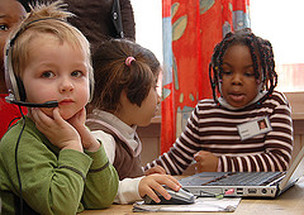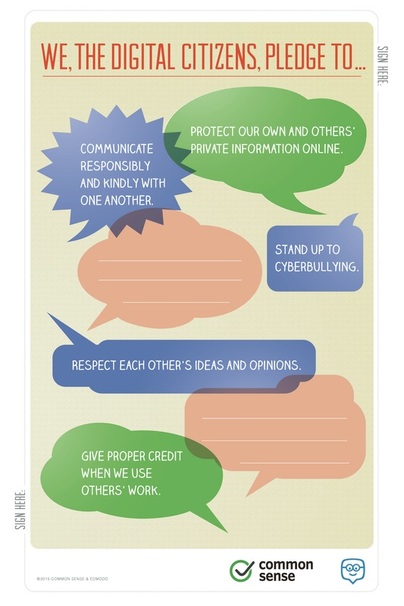What is Digital Citizenship?
|
"What is Digital Citizenship?"
By CyberWise |
We live in a new digital age where technology is easily accessed through the touch of a finger. Friends and family can communicate across the world through phones, texting and email. A picture or video can be uploaded and viewed by hundreds in merely seconds. Goods can be purchased and delivered right to our front doors. Students can complete online classes and earn degrees to better their education. Old friends can be reconnected and new relationships can be acquired. A person can depict a completely new identity for themselves through the use of social media. This new digital age we reside in offers many benefits, but also requires a new sense of ethical responsibility.
Digital citizenship is the act of appropriately using modern technology in a safe, respectful and responsible manner. Parents, teachers, and administrators have the important role of teaching and training young people to be responsible online users. Because technology is so widely used and offers many educational benefits, students need to understand how to behave while using technology. While the same set of manners used in everyday life transfers to the digital world, there are many new previsions students and adults must take while using technology. |
How can we teach students to become safe and respectful digital citizens?
|
Digital Citizen Institute urges parents, teachers, administrators and students to use the acronym REP (Respect, Educate and Protect) to better teach, learn and understand the nine themes of digital citizenship.
R- Respecting Yourself and Others: Respect is a crucial component when logging onto the Internet and using technology in general. Etiquette while using technology is just as important as using good manners in our everyday lives. The golden rule “treat others the way you want to be treated” applies to usage of technology as well. Students, as well as adults, should be sensitive to the fact that not everyone has the same digital access to modern technology and, therefore, do not have the same opportunities. Just as there are a set of laws citizens of The United States must follow, digital citizens also must abide by a set of laws. Hacking, stealing, plagiarizing, creating viruses and sending spam are all immoral actions that have severe consequences. E- Educate Yourself and Connect with Others: Knowing and understanding how to use technology in a safe and productive way is an important tool to digital citizenship. Educators and parents must develop digital literacy skills in order to teach to students how to work, learn and produce using technology. One of the largest developments in this new digital age is the capability to communicate with each other. This is positive in many aspects, but can also be extremely dangerous if not done appropriately. Another large development is the ability to buy and sell goods using the Internet or digital commerce. This is convenient and beneficial in many ways, but also comprises the buying and selling of illegal goods. P- Protect Yourself and Others: While using this wonderful advancement, it is important to protect yourself, your identity and personal information. Just as American citizens are endowed to rights and responsibilities, so are digital citizens when using technology. Much like we teach children not talk to strangers and other safety rules, we also need to instill digital security rules about protecting our information and devices. Digital health and wellness is an essential topic to discuss with students so the risks of eye safety, repetitive stress syndrome, Internet addiction and other dangers can be prevented. |
Tips for Parents:

Marsali Hancook, president of iKeepSafe.org and author of “Preparing Our Children for Global Digital Citizenship Success”, advocates these tips to parents:
1. Keep Current: Always know the technology you child is using and logging on to.
2. Keep Communicating: Talk to your child about what they are doing with technology, where they are logging on to and who they are communicating with.
3. Keep Checking: Explain to your child about how to properly and safely use technology and the Internet.
1. Keep Current: Always know the technology you child is using and logging on to.
2. Keep Communicating: Talk to your child about what they are doing with technology, where they are logging on to and who they are communicating with.
3. Keep Checking: Explain to your child about how to properly and safely use technology and the Internet.
Student Resources:
|
"Super Digital Citizen"
By Common Sense Media |
"5 Facts About Digital Citizenship"
By Amy Loder |
References:
Hancock, M. (n.d.). Preparing our children for global digital citizenship success. Retrieved from
http://www.everydayconnected.com/blog/digital_citizenship/index.html#.ViWh0-zzN8F
Marcinek, A. (2013). The path to digital citizenship. Retrieved from http://www.edutopia.org/blog/the-path-to-digital-citizenship-andrew-marcinek
Nine themes of digital citizenship. (n.d.). Retrieved from http://www.digitalcitizenship.net/Nine_Elements.html
By: Mary McGehee


